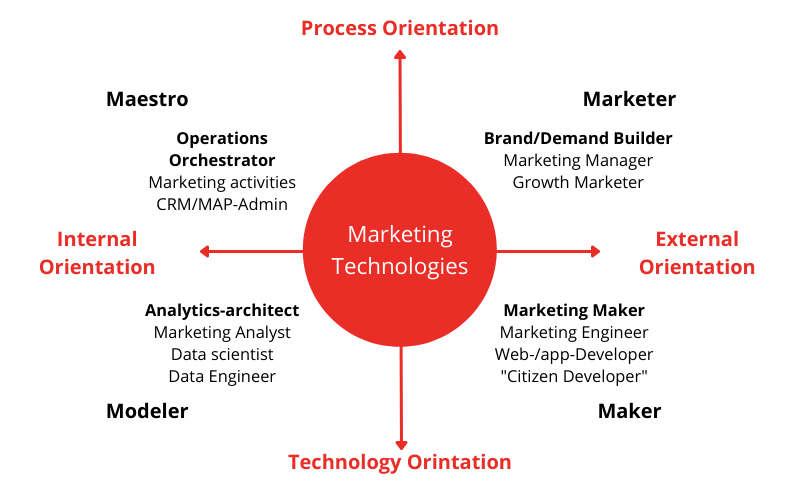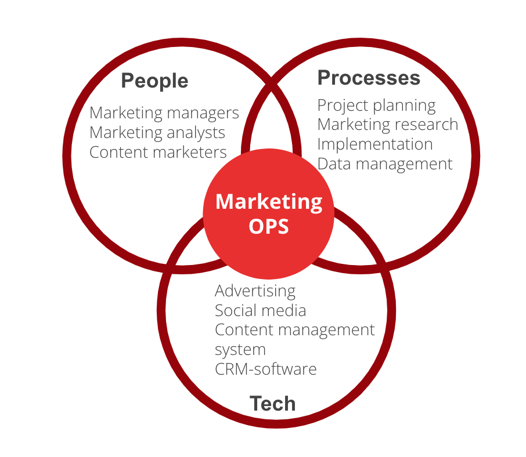Share this
How do you achieve the best results with MarketingOps?
by Jan Hendrik Fleury on Mar 25, 2022 8:55:45 AM

Marketing Operations Managers have become strategic integrators of both the CMO and key cross-functional stakeholders in areas such as product, IT, data science, and customer service. MarketingOps leaders are now orchestrating business and customer outcomes at the intersection of creativity and technology. To provide and maintain continuous marketing-related services controlled and at scale. This is crucial in the always-on economy where speed and flexibility have become 'must have capabilities'.
This is the second part of the triptych:
You can read the 'what?' and 'why?' of MarketingOps in the first article.
This second episode is about the 'how' to get results with MarketingOps.
The third part is about setting up MarketingOps teams.
The daily activities of a MarketingOps team consist of collecting data, creating cross-channel reports, and creating dashboards based on this data to support the entire marketing domain. They develop and maintain marketing and data products. In addition, a MarketingOps team is involved in data and technology management. Managing data and ensuring the reliability of data and insight is essential to tailor communication in every communication moment to the target group.
The Marketing Ops functions and roles in the teams can be represented as follows:

In this framework, you see the relationship between the orientations 'process vs technology and 'internal vs external'. In addition, the functions and roles are shown. With this framework, the relationships become clear. Each role is necessary and creates conditions for another role. If you get this all working, you can work quickly, scalable and controlled. And this makes the work more fun because more results and you understand each other well.
What challenges do sales and marketing face?
Today, sales and marketing teams face a number of challenges such as:
- Lead generation:
Many marketers find it difficult to generate web traffic and lead from it. There is an overload of good relevant content and it is becoming increasingly difficult to distinguish yourself.
- Measuring ROI:
Marketing and sales departments face challenges when measuring the ROI of their marketing activities. Namely, without collecting the data from all channels, transforming it into a usable whole, and then analyzing it, it is often difficult to say what works best for customers and the company.
- Budget
If marketing cannot properly determine the ROI, the budget can come under pressure. That is not the case if your ROI is clear and every extra Euro yields demonstrable value.
- Difficulty reacting quickly to changing internal and market conditions. Because often the right data is not collected and analyzed, it is not possible to react quickly enough to changes.
How can MarketingOps help solve these challenges?

In the image above, in addition to the framework, you can see how MarketingOps is in the middle of people, processes, and tech. The organization of a MarketingOps team is based on roles instead of functions and depends on the backlog being worked on.
What can you do to get better results?
MarketingOps can be seen as the backbone of the marketing department. When a MarketingOps team does its job well, marketing teams deliver the right message to the right people at the right time and with optimal ROAS, with the right measurement tools. An important element can be optimizing and automating the buyer's journey. By continuing to optimize this process, you get more leads and MarketingOps can play a major role in this. You can do the following in the lead generation example:
Lead Generation:
Know where your leads come from. Follow your leads up to conversion and map out the touchpoints. Ensure that marketing data can be collected and analyzed in a uniform manner.
- Use lead scoring
Lead scoring is the process of assigning values to each lead you have generated. You can score your leads based on multiple attributes. For example, how they came into contact on your website and what information they left behind. Allows the team to prioritize leads. Using lead scoring also has a positive effect on your ROI. Because this becomes transparent, it is also easier to allocate a sufficient marketing budget.
- Use lead tracking
With lead tracking, you look at where a lead comes from and you actively keep track of where leads are located in the sales and marketing funnel. In addition, you perform actions to get the lead to the next stage of the sales funnel as quickly as possible and ultimately close the deal. To be able to do this effectively, a good system that organizes lead tracking is of great importance. The Marketing Ops team must keep the database clean and help set goals and KPIs.
Optimize processes:
One of the most important functions of MarketingOps is to design and implement processes that incorporate the right technology to analyze data properly so that the marketing team can demonstrate its value to the company. By making results measurable,
Measure the success of campaigns:
Often marketers set up successful campaigns but forget to use the tools needed to measure success. The Marketing Ops team should build this measurement process into their campaigns and show the marketing team how to take these measurements. You can do this by setting up campaigns that have specific goals that can be quantified.
“MarketingOps is all about connection. Connecting systems, connecting strategies to tools, and connecting customers to relevant information”
Marketing Operations and the Tech Stack
Selecting, managing, and maintaining the right tools that can help automate your marketing activities is an essential part of Marketing Operations. The main tasks in managing the tech stack are:
- Assessing the suitability of new tools
- Integrating these tools in such a way that they deliver value and support the marketing process.
- Managing accounts and permissions
In addition, we have the following tips for you to manage your tech stack properly:
Avoid overlap
Marketers use many different tools simultaneously to manage campaigns and data. This means that there is a chance of overlapping functionality. This can cause inconsistent data or obscure insights. And unnecessary costs.
Work Future-Oriented
When managing your tech stack, it is important to have a flexible and scalable architecture to be ready for any future scenario. Developing a roadmap can help you seamlessly integrate new tools and functionality. Make sure that you avoid vendor lock-in as much as possible, as our DDMA committee has written in Emerce in the article Get the most out of your marketing technology: 6 handles for a MarTech stack.
Compliance
Marketing departments must ensure that they comply with privacy regulations. MarketingOps is responsible for ensuring that all marketing materials and analytics and activation comply with all internal and external guidelines.
Tasks of MarketingOps to facilitate this are:
- Reviewing and approving content
- Obtain legal approval, involve legal at the start
- Check consent on the goals you have
- Facilitating review tools
Compliance is one of the trickiest parts of MarketingOps. That's why it's best to start by developing a review and approval workflow and integrate it into your marketing projects. This workflow ensures that you can work in a systematic way and never skip the compliance phase.
Conclusion
MarketingOps is all about connecting processes, systems, and people. The marketing and sales departments are supported with the right data, applications, and workflows. This gives them better insight into the buyer's journey and on which points they can optimize it. In addition, their efforts can be made more measurable, so that the marketing ROI is clear.
ABOUT CRYSTALLOIDS
Crystalloids helps companies improve their customer experiences and build marketing technology. Founded in 2006 in the Netherlands, Crystalloids creates crystal-clear solutions that turn customer data into information and knowledge into wisdom. As a leading Google Cloud Partner, Crystalloids combines experience in software development, data science, and marketing, making them one of a kind IT company. Using the Agile approach, Crystalloids ensures that use cases show immediate value to their clients and make their job focus more on decision making and less on programming.
Share this
- November 2025 (2)
- October 2025 (2)
- September 2025 (3)
- August 2025 (2)
- July 2025 (1)
- June 2025 (1)
- April 2025 (4)
- February 2025 (2)
- January 2025 (3)
- December 2024 (1)
- November 2024 (5)
- October 2024 (2)
- September 2024 (1)
- August 2024 (1)
- July 2024 (4)
- June 2024 (2)
- May 2024 (1)
- April 2024 (4)
- March 2024 (2)
- February 2024 (2)
- January 2024 (4)
- December 2023 (1)
- November 2023 (4)
- October 2023 (4)
- September 2023 (4)
- June 2023 (2)
- May 2023 (2)
- April 2023 (1)
- March 2023 (1)
- January 2023 (4)
- December 2022 (3)
- November 2022 (5)
- October 2022 (3)
- July 2022 (1)
- May 2022 (2)
- April 2022 (2)
- March 2022 (5)
- February 2022 (2)
- January 2022 (5)
- December 2021 (5)
- November 2021 (4)
- October 2021 (2)
- September 2021 (1)
- August 2021 (3)
- July 2021 (4)
- May 2021 (2)
- April 2021 (2)
- February 2021 (2)
- December 2020 (1)
- October 2020 (2)
- September 2020 (1)
- August 2020 (2)
- July 2020 (2)
- June 2020 (1)
- March 2020 (2)
- February 2020 (1)
- January 2020 (1)
- November 2019 (3)
- October 2019 (2)
- September 2019 (3)
- August 2019 (2)
- July 2019 (3)
- June 2019 (5)
- May 2019 (2)
- April 2019 (4)
- March 2019 (2)
- February 2019 (2)
- January 2019 (4)
- December 2018 (2)
- November 2018 (1)
- October 2018 (1)
- September 2018 (2)
- August 2018 (3)
- July 2018 (3)
- May 2018 (2)
- April 2018 (4)
- March 2018 (5)
- February 2018 (1)
- January 2018 (3)
- November 2017 (2)
- October 2017 (2)



